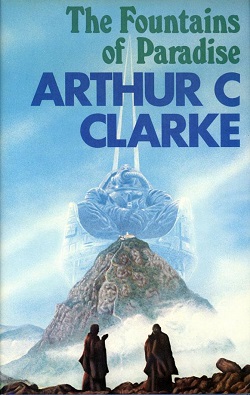The Fountains of Paradise

Cover of first UK edition (hardcover)
|
|
| Author | Arthur C. Clarke |
|---|---|
| Cover artist | Terry Oakes |
| Country | United Kingdom |
| Language | English |
| Genre | Science fiction |
| Publisher |
Victor Gollancz (UK) Harcourt Brace Jovanovich (US) |
|
Publication date
|
1979 |
| Media type | Print (Hardback & Paperback) |
| Pages | 256 |
| ISBN | |
| OCLC | 4993570 |
The Fountains of Paradise is a novel by British writer Arthur C. Clarke. Set in the 22nd century, it describes the construction of a space elevator. This "orbital tower" is a giant structure rising from the ground and linking with a satellite in geostationary orbit at the height of approximately 36,000 kilometers (approx. 22,300 miles). Such a structure would be used to raise payloads to orbit without having to use rockets, making it much more cost effective. The novel won both the Hugo and Nebula Awards for Best Novel.
In the 22nd century, Dr Vannevar Morgan is a famous structural engineer who hopes to develop the "space elevator" from a theoretical concept to reality and enlists the resources of his employers to carry out experiments. But the only suitable starting point (Earth station) for the elevator lies at the summit of a mountain in Taprobane occupied by an ancient order of Buddhist monks, who implacably oppose the plan.
Morgan is approached by a Mars-based consortium to develop the elevator on Mars as part of a massive terraforming project. To demonstrate the viability of the technology, Morgan tries to run a thin cable of "hyperfilament" from an orbital factory down to ground level at Taprobane. A monk at the monastery, a former astrophysicist who is a mathematical genius, tries to sabotage the attempt by creating an artificial hurricane using a hijacked weather-control satellite. His attempt succeeds, but the hurricane blows butterflies to the peak of the mountain. This fulfills an ancient prophecy that causes the monks to leave the mountain. The tower can be built on Earth after all.
Forced to resign his position for acting beyond his authority, Morgan joins the Martian consortium named "Astroengineering" and construction of the Tower commences.
Several years later, the Earth-based tower is well under construction and travel up and down—both for tourists and for transfer to rocket ships—is being trialled.
An astrophysicist and a group of his students and tower staff are stranded in an emergency chamber six hundred kilometres up after an accident with their transport capsule. They have limited food and air supplies. Whilst a laser on a weather-control satellite is able to supply heat, it is imperative to provide them with filter masks against the increasing carbon dioxide and also with food, air, and medical supplies.
...
Wikipedia
